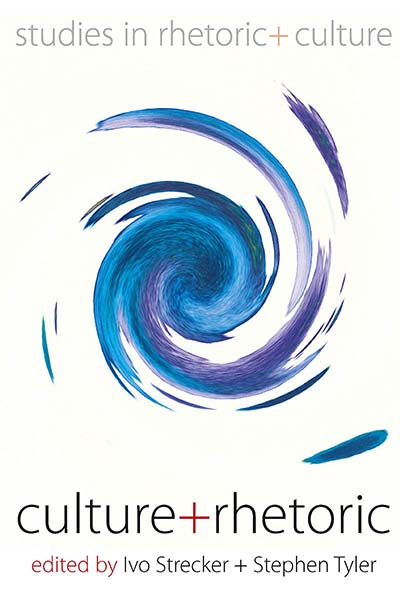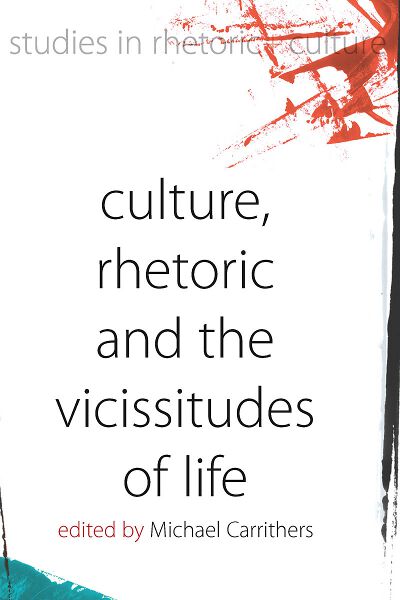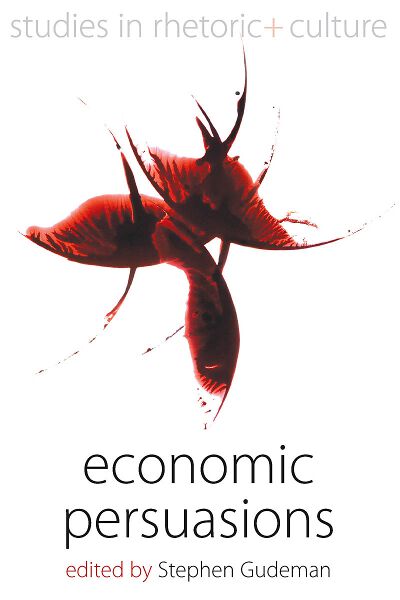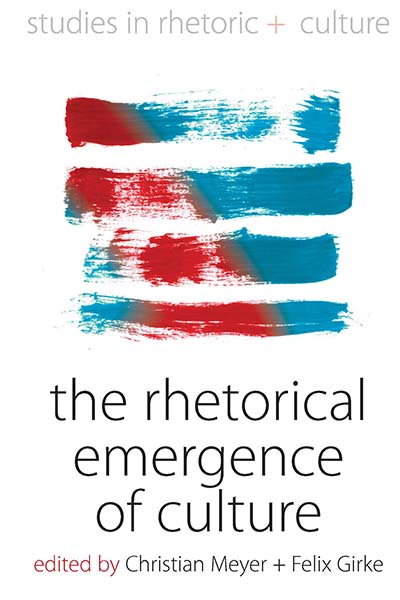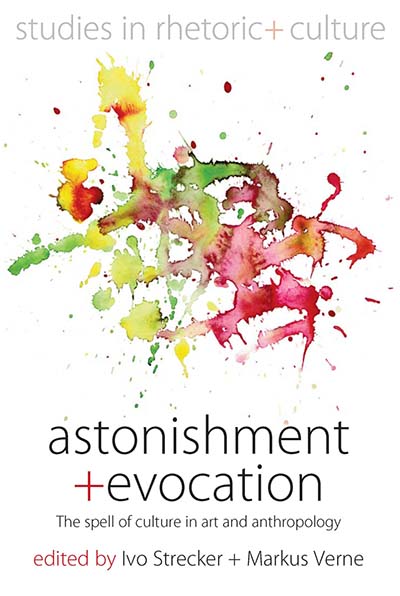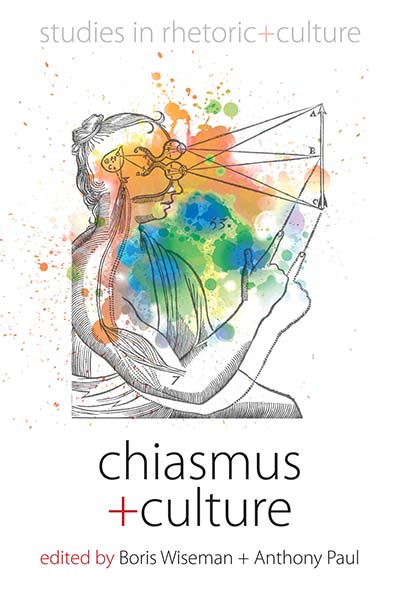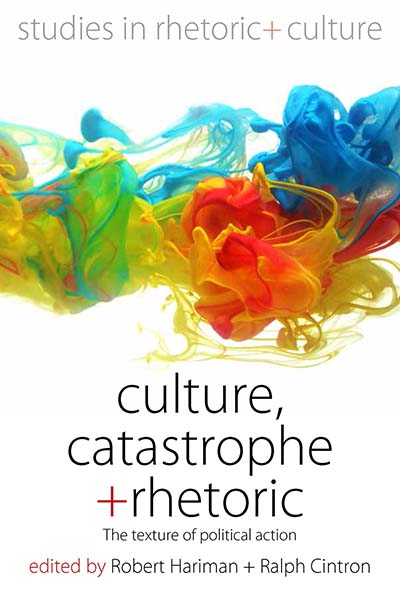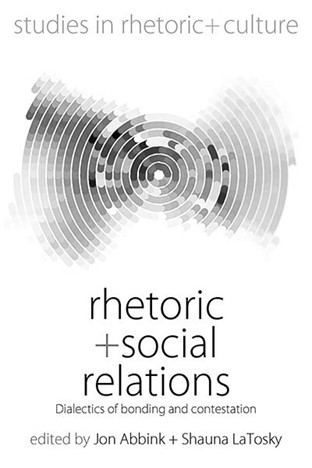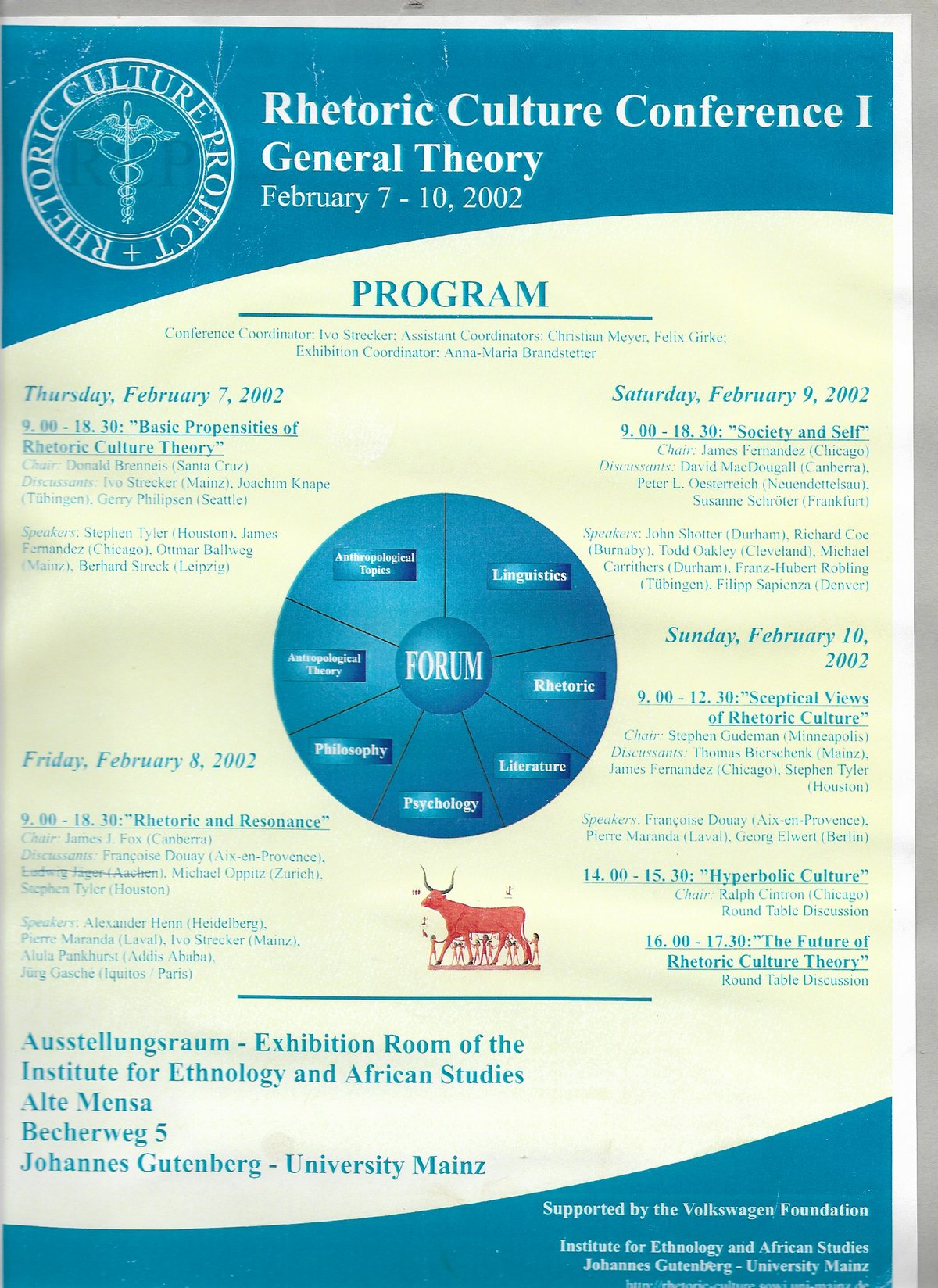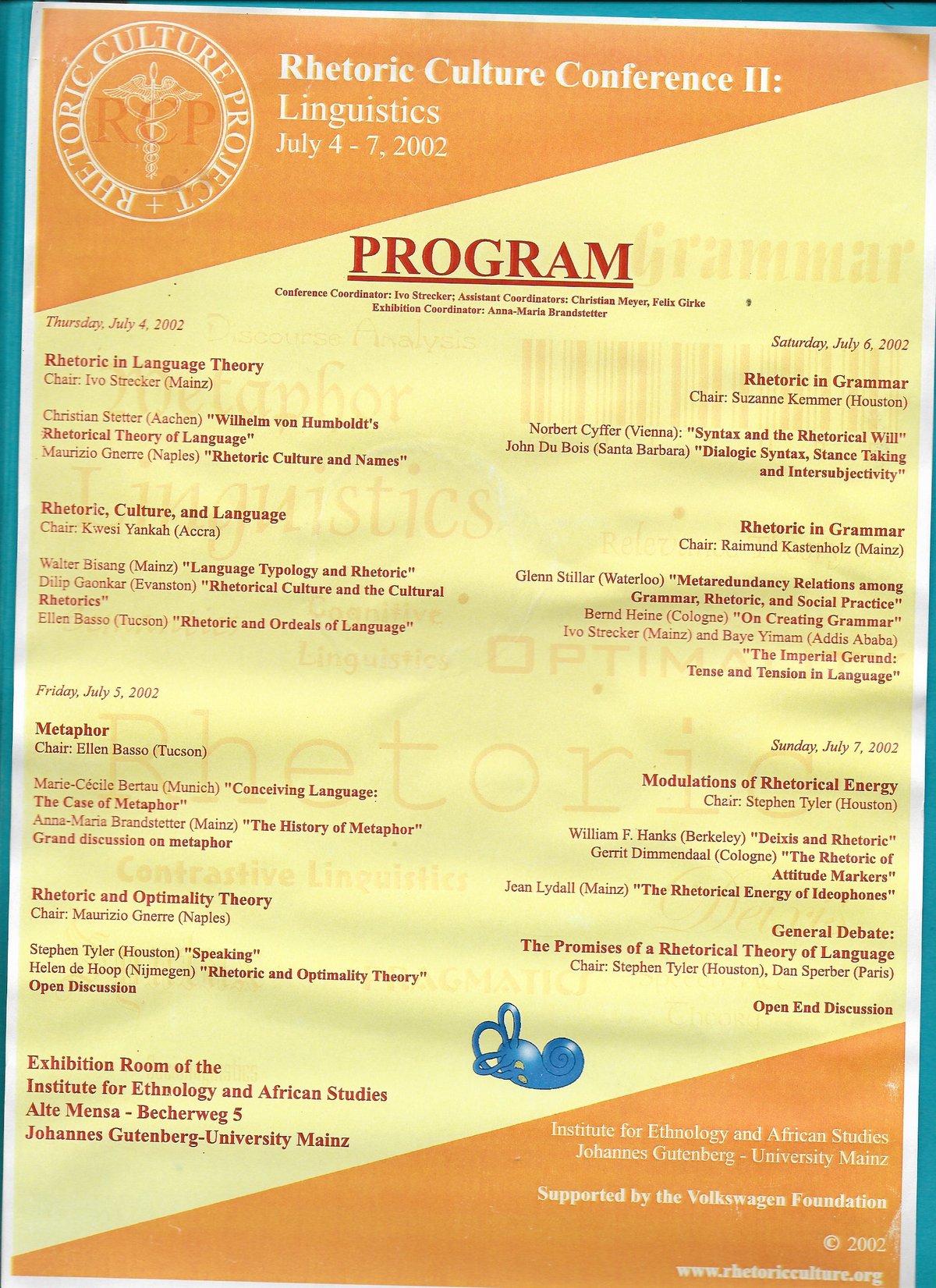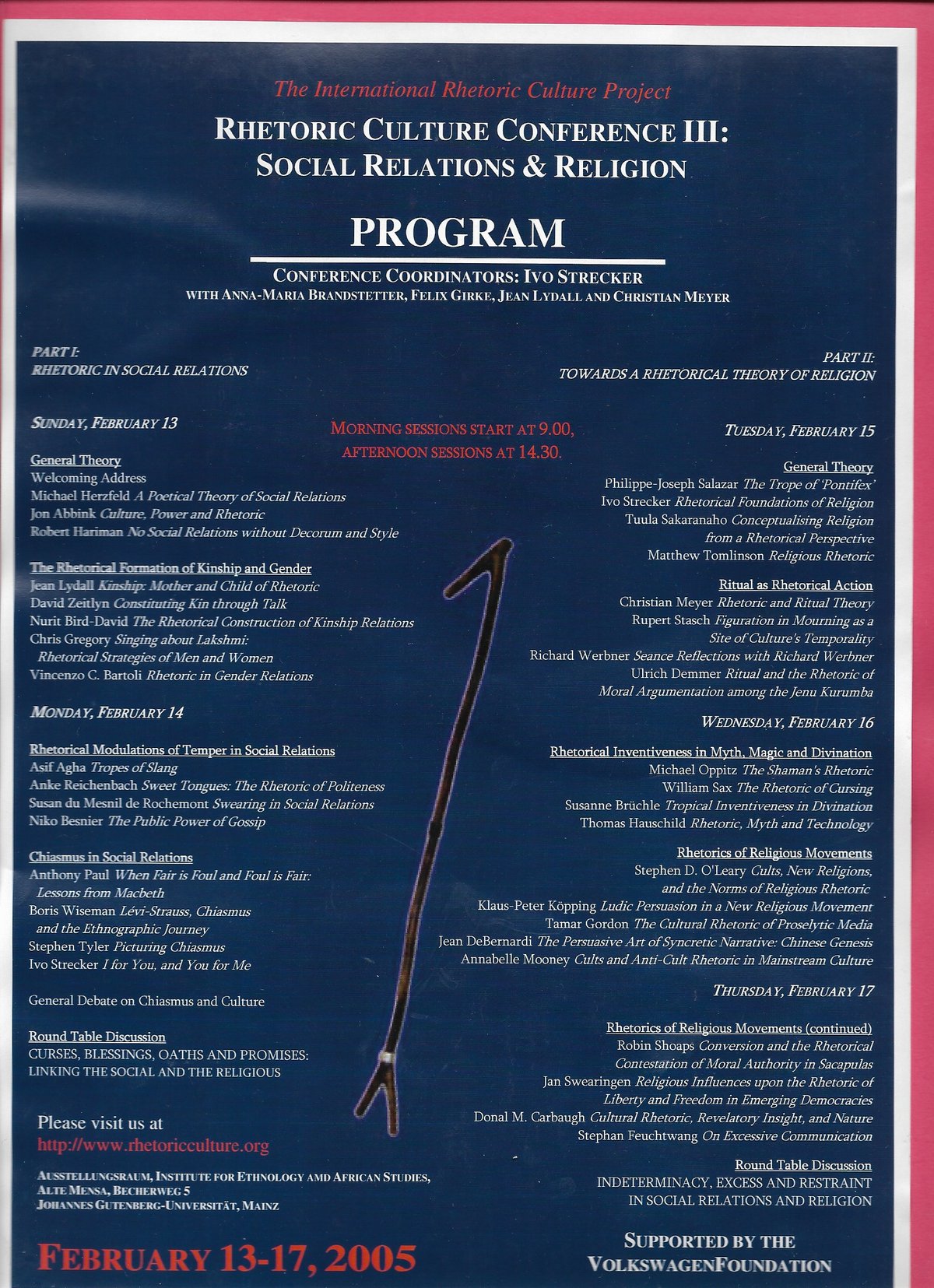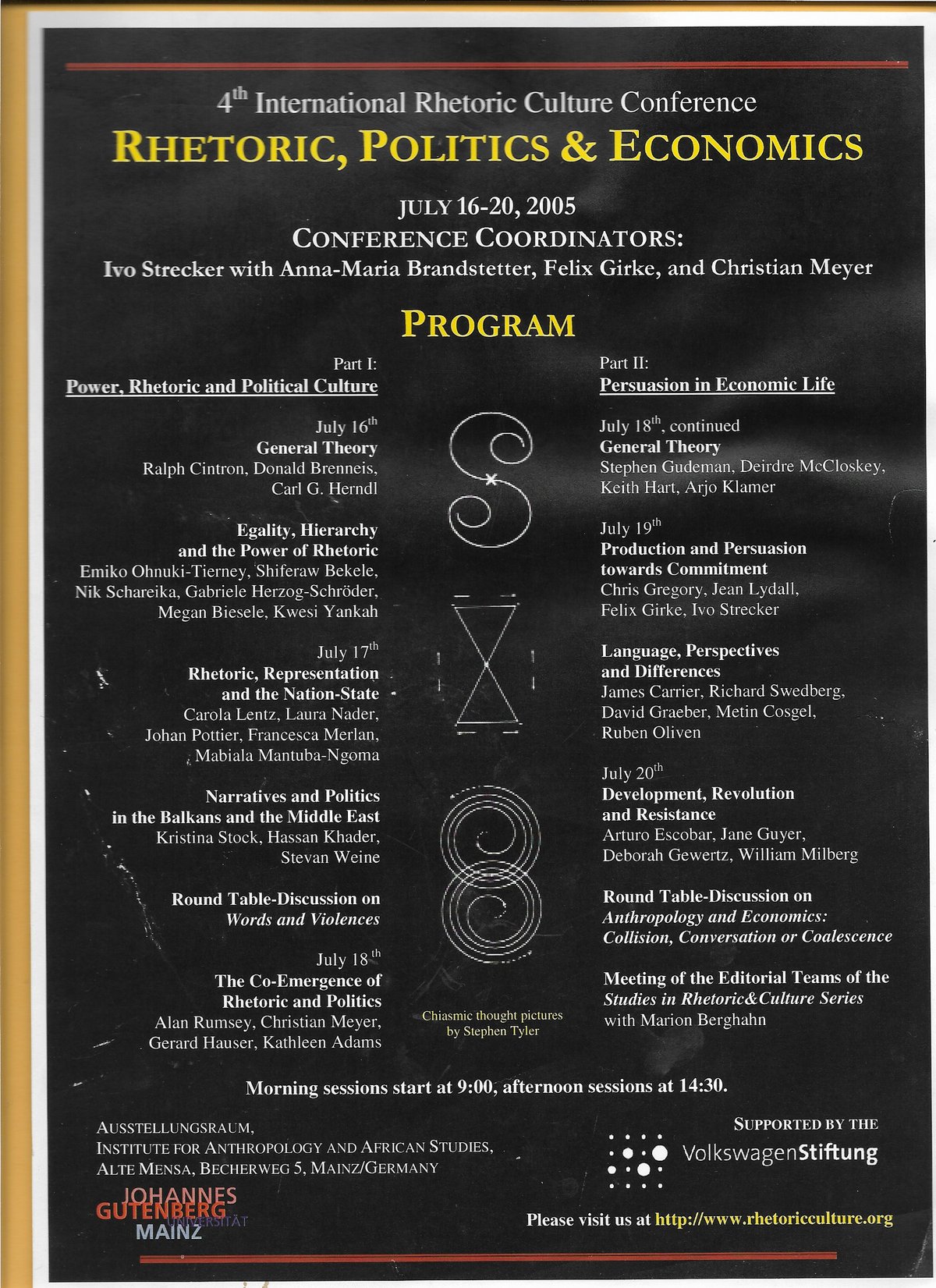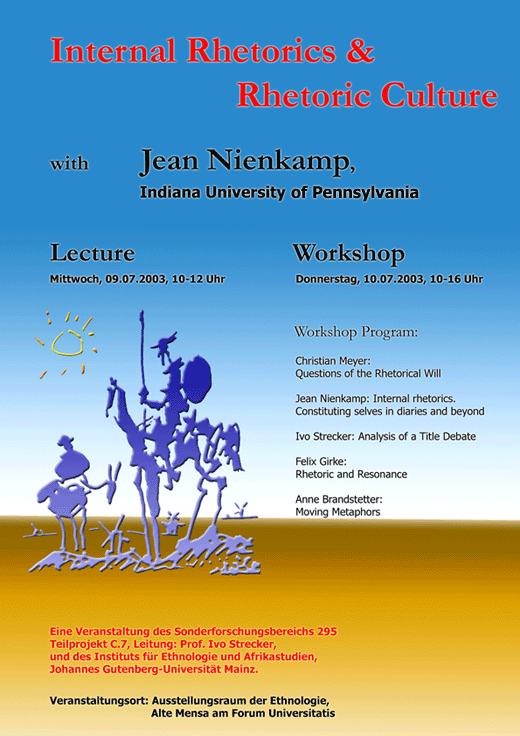International Rhetoric Culture Project
The website rhetoricculture.org has been replaced by this site

The International Rhetoric Culture Project emerged over the last twenty years as an interdisciplinary theoretical venture seeking to integrate rhetorical analysis, contemporary methodologies and ethnographic attention to a broad range of fields and phenomena. While for its earlier years it had its institutional center of gravity at the University of Mainz, 'Rhetoric Culture' is more loosely tethered to the University of Konstanz today, while being sustained by our many partners and contributors across the globe.
Outline and Overview
What is Rhetoric Culture Theory?
‘Rhetoric Culture’ was first coined by Tyler and Strecker as the title for a workshop at the 5th Biennial Conference of the European Association of Social Anthropologists held in Frankfurt/Main 4th - 7th September 1998. The conference was devoted to The Politics ofAnthropology. Conditions for Thought and Practice, and the workshop on Rhetoric Culture was meant to help overcome the state of limbo in which cognitive, symbolic, dialogic, and all sorts of discursive anthropologies have left us. Its was to provide a new - or rather very old - direction and sense of relevance to the study of culture by retrieving, exploring and making full use of the ancient insight that just as rhetoric is founded in culture, culture is founded in rhetoric. The idea, that such a project might be possible and that it was time to establish a forum where the interaction between rhetoric and culture could be discussed, had in turn grown out of work begun by Tyler in The Said and the Unsaid (1978) and Strecker in The Social Practice of Symbolization (1988).
In a world whose imaginative processes and social structures are seemingly undergoing dramatic reconfiguration brought about by the technology of the internet and other media, it may seem anachronistic to look for inspiration in rhetoric which many would not hesitate to call antiquated, even discredited. These new technologies of communication have, however, merely brought problems of social order into sharper focus, without being able to provide solutions to the problems they so clearly moot. It is this failure of auto-critique that impels us to refract these new technologies through the prisms of rhetoric, for rhetoric is not constrained by the structure or pre-requisites of any single culture or technological complex and thus holds out the possibility of a contemporary discussion that is not informed and pre-determined at the outset by the structure of technology.
Echoes from the Past
It will be important for the Rhetoric Culture Project to carefully study the past and see what can be learnt from earlier theories of culture. We call this section ‘echoes from the past’ in order to indicate that such a study has not yet begun and that at the present moment we only want to mention some of the most prominent voices which ‘echo’ in our minds. Our reminders are extremely short and do not quote authors in their original language. The translation of Wilhelm von Humboldt’s texts is our own.
The maxims which Ptahhotep, vizier of the pharao Djedkare-Isesi (5th dynasty) of the Egyptian Older Kingdom (2350 B.C.) formulated, suggest that already the ancient Egyptians knew rhetoric to be a powerful tool for confronting and bending the will of others and for defining and transforming social situations. The following maxim shows how even silence may ‘speak’ and be part of such rhetoric. It says: “If you meet a disputant in action, a powerful man, superior to you, fold your arms, bend your back, to flout him will not make him agree with you. Make little of the evil speech by not opposing him while he is in action; He will be called an ignoramus, your self-control will match his pile (of words)” (Lichtheim 1975 I:63).
We like to add here the words of an old sage from Hamar (southern Ethiopia). These words were told to us recently, but are based on ancient traditions of thought which, for all we know, may well go back to the time of Ptahhotep, or even before him. When asked to give an account of the history of his country, Baldambe (‘Father of the Dark Brown Cow’) began with the following reflections which clearly show an understanding of the rhetorical nature of culture:
“Well, one says what one knows. What one doesn't know one can't tell. He who tells one something is the father. The one who speaks to the children, it is the mother. Some have a father who dies already when he or she is still a child but then there is still the mother and it will be she who instructs the children. The mother has earlier on heard the word of the fathers. The fathers have said this and that. My father too has told me many things a long while ago. Parents talk to their children. In this way they bring up the children.
But if the child doesn't listen, then the father and the mother will neglect it and it will not grow up. It will not find anything. It will not collect anything. It will not have children and will not marry any woman. ‘Look, earlier this child didn't listen to the word of the fathers and of the mothers. It didn't listen to the word of the mother's brother nor to that of the age mates of its father’. In this way children grow up. Barjo (fortune) sits on their shoulders and closes or opens their ears. These things are told to the children so that they know that he who doesn't listen to the word of the fathers will become a thief and will die through the words of a thief and will become impoverished through the words of a thief. These are the teachings of the age-mates” (Strecker, unpublished manuscript).
As is well known, the Sophists of ancient Greece held speech to be “a mighty ruler who almost without effort performs godlike deeds”, and “reduces fear, takes away pain, brings joy and enhances compassion” (Gorgias Eulog. Hel. 11,8; 427 B.C.). The Sophists thus figure prominently among the ancestors of Rhetoric Culture Theory, just as Isokrates (436-383) whose outline of the power of persuasion reads almost like a general introduction to Rhetoric Culture Theory even today. Brian Vickers in his seminal book In Defense of Rhetoric (1988) was the first to re-direct our attention to Isokrates quoting him as follows:
“In most of our abilities we differ not at all from the animals; we are in fact behind many in swiftness and strength and other resources. But because there is born in us the power to persuade each other and to show ourselves whatever we wish, we not only have escaped from living as brutes, but also by coming together have founded cities and set up laws and invented arts, and speech has helped us attain practically all of the things we have devised. For it is speech that has made laws about justice and injustice and honour and disgrace, without which provisions we should not be able to live together. By speech we refute the wicked and praise the good. By speech we educate the ignorant and inform the wise” (Isocrates 1928: 326).
Roman rhetoric also provides well known examples of early Rhetoric Culture Theory .Cicero and Quintilian (Cicero, de orat., 1.8.30-4; Quintilian, Inst. Orat. II, 16, 9-10) both agreed that rhetoric, and only rhetoric, had the power to produce and reproduce culture and society. Only rhetoric could create a sense of community, conjure a common history and articulate the common values and sentiments on which the communitas could be built.
In the wake of the Renaissance Giambatista Vico fought a spirited fight against Cartesian philosophy, arguing that man in truth could only fully understand what he had created himself, that is culture. In his “Principles of a New Science concerning the Nature of the Nations” (1725) he developed a theory of how the history of culture was based on rhetorical imagination. Culture, he said, was created poetically, in fact it was like a large extended metaphor developed by our faculty for, and obsession with, analogical thinking, like in the following example, where, in the chapter on ‘Poetic Economy’, he illustrates the advent of cultivation:
“539. Hereupon, by a fine natural and necessary metaphor, they called the ears of grain golden apples, transferring the idea of the apples which are fruits of nature gathered in summer, to the ears of grain which human industry gathers likewise in summer. 540. (...) And, in other metaphors both beautiful and necessary, they imagined the earth in the aspect of a great dragon, covered with scales and spines (the thorns and briers), bearing wings (for the lands belonging to the heroes), always awake and vigilant (thickly grown in every direction)” (1961:145-46).
Of all the echoes that reach us from the past, the voice of Wilhelm von Humboldt (1776-1835) is here probably the most important. Like Giambattista Vico, he argued against Cartesian indifference to language and against the Cartesian formula of 'ratio=logos minus oratio'. In an attempt to re-connect philology and philosophy as in classical Greek tradition, where rhetoric had been central to the study of ‘logos', von Humboldt emphasized the ontological unity of 'oratio' and 'ratio' in 'logos' and insisted that reason was inseparable from language, thought inseparable from speech.
The 'I', he said, critically depends on the 'You'. It needs the 'You' whose power of thought radiates back to the 'I', and vice versa. As the 'I' and the 'You' engage in discourse, their very use of language presumes the other's power of thought. It presumes, that the 'You' will try to understand the 'I' although it knows from experience the potential vicissitudes of language. We humans simply have no other choice, for between the power of thought of the 'I' and the power of thought of the 'You' there is “no other mediator but language” (1995:24).
Note that von Humboldt spoke of language not as tool, nor did he speak of it as product (ergon) but as process and activity (energeia). In Ueber die Verschiedenheit des menschlichen Sprachbaues und ihren Einfluss auf die geistige Entwicklung des Menschengeschlechts (1830) he wrote: “Language is the eternally repeated work of the mind, enabling the articulated sound to express thought. Taken strictly, this is a definition of (what is happening in individual acts of) speaking; but in a true and essential sense one may view language to constitute the totality of such speaking” (1995:36).
This, then, is what one can rightly call Wilhelm von Humboldt's rhetorical theory of language. Language is a process, the emerging and creative work of individual minds interpreting and re-interpreting their cultural heritage: “As each language has received its substance from unknown earlier periods, the work of the mind which generates the exchange of thoughts is always simultaneously directed towards something given, not purely creating, but refiguring” (1995:38).
Here von Humboldt evoked the image of man using his creative rhetorical disposition to 'spin out' language only to then get caught up in its web. His famous formulation runs as follows (note how close it is Clifford Geertz' characterization of culture as a 'web of significance' in which man traps himself):
“Man lives with objects (objects which surround him) mainly, or rather, - as feeling and action depend on the ideas which he entertains about the objects -, exclusively in the way in which language presents them to him. The very activity by which he spins language out from within himself eventually gets himself entwined in it, and every language draws a circle around the nation to which it belongs, and which one can only leave to the extent that at the same time one enters the circle of another” (1995:53).
If one was to generalise and speak here of 'culture' rather than simply of 'objects' one would see how close von Humboldt was to a rhetorical theory of culture, especially if one adds Humboldt's awareness of the constraints and the freedom afforded to us by language, for at the end of the paragraph which presents his most mature 'reflections on the nature of language' he writes:
“Language assumes its final distinctiveness in the individual. Upon hearing a word, no one thinks precisely what the other does, and even the smallest difference trembles, like a circle in the water, on through the whole language. All understanding is therefore simultaneously a non-understanding, all mutual agreement a moving apart in thought and feeling. The way in which language is modified in every individual shows man’s power over it...The influence exercised on him (on man) reflects the rule-relatedness of language ..., and his response reveals a principle of freedom. For there may rise in man something which no reason could find in any of the preceding states (of man, language, and culture) and one would misunderstand the nature of language and violate the historical truth of its development and change, if one was to exclude the possibility of such unexplainable phenomena” (1995:59).
In the more recent past, an important contribution to Rhetoric Culture Theory came from Kenneth Burke, who may justly be called one of the fathers of current Rhetoric Culture Theory. He transformed ‘Aristotelian’ Rhetoric into ‘post-Christian’ Rhetoric and stressed that rhetoric plays a crucial role in socialization and hence in the formation of cultural rules and patterns of behaviour. Here it may suffice to quote the famous passage where he speaks of the need to be “alert to the ingredient of rhetoric in all socialization, considered as a moralizing process. The individual person, striving to form himself in accordance with the communicative norms that match the cooperative ways of his society, is by the same token concerned with the rhetoric of identification. To act upon himself persuasively, he must variously resort to images and ideas that are formative. Education (‘indoctrination’) exerts such pressure upon him from without; he completes the process from within. If he does not somehow act to tell himself (as his own audience) what the various brands of rhetorician have told him, his persuasion is not complete. Only those voices from without are effective which can speak in the language of a voice within” (Burke 1950:39).
Finally, let us draw attention to the fact that the ever more refined and prolific anthropological study of metaphor - and generally the interplay of tropes – which we have witnessed during the past decades, has contributed much to the emergence of rhetoric culture theory. For a long time already, anthropologists had been interested in metaphor, allegory, symbol etc., like James G. Frazer (1968/11890; 1927), Franz Boas (1911, 1940/11929) and Paul Radin (1945, 1950), but only the “metaphoric turn” in the mid of the 20th century gave the crucial impulse that brought research on metaphor to the forefront of anthropology. Influenced by Jakobson (1956), Claude Lévi-Strauss (1962) demonstrated how the totemic and mythic cosmos that people create for themselves and others can be understood as a kind of mental ‘bricolage’ that works by means of ‘metaphoric and metonymic operations’. This thought provoking idea led to a number of fruitful and influential studies, like for example Thomas Beidelman (1975), James Fox (1971), James Fernandez (1972, 1974), Michelle Rosaldo (1972, 1973), Renato Rosaldo (1968) and Stanley Tambiah (1968, 1969).
The first publication in anthropology to carry both ‘metaphor’ and ‘rhetoric’ in its title was the book edited by David Sapir und Christopher Crocker The social use of metaphor. Essays in the anthropology of rhetoric (1977). It was dedicated to Kenneth Burke (1945b, 1957, 1966) and showed both theoretically and empirically how metaphors are not only ‘good to think with’, ‘good to speak with’ or ‘good to write with’ but are especially “good to live by”, as George Lakoff and Mark Johnson would put it a few years later (Lakoff/Johnson 1980a, 1980b). Of all the contributors it was James Fernandez who most vigorously continued the new ‘anthropology of rhetoric’ advocated in The social use of metaphor. First he presented a collection of essays entitled Persuasions and performances. The play of tropes in culture (1986), then he edited a collection of essays under the title Beyond Metaphor. The theory of tropes in anthropology(1991), and most recently he co-edited with Mary Taylor Huber a book on Irony in action. Anthropology, practice and the moral imagination (2001), with chapters by Paul Friedrich, James Clifford, Michael Herzfeld, James Boon and other scholars inside and outside anthropology whose work can be considered as being close to rhetoric culture theory.
Present Concerns
As we have said above, Rhetoric Culture Theory explores how rhetoric is founded in culture, and how culture is founded in rhetoric. It starts from the fact that 'homo sapiens' is an incessant talker. Even when we are silent we keep talking to ourselves, and even in our sleep we hear voices and speak aloud in our dreams. Our minds are filled with ideas and images, but these tend to remain unstable and incomplete as long as we do not use language, or rather inward and outward speech. It is speech - addressed both to ourselves and others - which allows us to give some kind of shape and structure to our understanding of the world.
Furthermore, speech is central to the formation of consciousness and the self. In The Said and the Unsaid Tyler has explained this as follows: "It is not just that the act of speech itself logically requires the other as an objective or mechanical terminus of a message, but more importantly it is only through others that the self reveals itself and comes to know itself as something more than an object. Without the other there is no self... Consciousness, and more particular consciousness of self, cannot emerge except in a context of intercommunication, and it is speaking which provides the paradigm for intercommunication" (1978:141).
Rhetoric both enables and constrains us to think, speak and act intentionally in a world which is "neither anarchic nor determined" (Tyler 1978:135). and it is our innate rhetorical disposition and our culturally acquired rhetorical competence which create the 'patterns', 'styles', 'configurations', 'habitus', 'paideuma', 'ethos', 'spirit' etc. of culture (Bateson 1958, Benedict 1934, Bourdieu 1977, Frobenius 1921). Even the 'codes', 'systems' and 'structures analysed by semiotics may be explained in these terms, for, as Clifford Geertz has observed, they are nothing but "webs of significance" we ourselves have spun (1973:5).
Just as there is no ‘zero degree rhetoric’ in any utterance (Kennedy 1998:5), there is no ‘zero degree rhetoric’ in any of the patterns of culture, and rhetoric which in its broadest sense may be understood as an emanation of mental and emotional energy (see Humboldt above and Kennedy 1998:5) is so powerful and ambiguous that it can be called the gravitational force of culture. If culture is ubiquitous, so is rhetoric, - if by that we mean the practices of discourse that enable communication and facilitate both the everyday and the critical performance of participants. What we implicate by the concept of rhetoric culture is just this mutuality of rhetoric and culture. There is then not an opposition between rhetoric and non-rhetoric but a cline of kinds and modes of rhetoric that traverse realities ranging from concrete speech events through text analysis to virtual worlds.
Analogy is perhaps one of the most evident forms in which rhetoric manifests itself as the gravitational force of culture (see Vico’s concept of poetic culture above). In the following passage, Tim Ingold has recently gone so far as to call it the ‘drive of culture’: “The essence of culture”, he writes, “lies in a uniquely human capacity to recognize and exploit likeness, or, in other words, to operate analogically. To construct an analogy (or metaphor) is to establish a relation between phenomena drawn from different domains of experience, in terms of a perceived similarity. Any real-world objects, as it is caught up in the nexus of analogical relations, can become a symbol. We can discover the meanings of symbols by attending to the multiple social contexts in which they are used: what each symbol does is to bring together these contexts into a single focus, the greater the symbolic resonance of the object by which it is represented. In the course of social life, new analogic linkages are forever being forged against the background of existing convention, only to become conventional in their turn: thus over time the meanings of symbolic change. The analogic drive, in short, is the very motor of the cultural process”(Ingold 1994: 334).
But although one may stress the constitutive and positive force of rhetoric in such a way, and although one may say, as Isocrates did (and so many who followed later), that it is speech which has “made laws without which provisions we should not be able to live together”, and that “by speech we refute the wicked and praise the good, (and) by speech we educate the ignorant and inform the wise", we also know too well, that by the same token it is speech which misinforms the wise and misleads the ignorant, praises the wicked and perverts the good. For this reason in the course of history rhetoric often fell into disrepute, was censored and declared to be a tool of the devil. But to expel the devil also meant to destroy the ethical basis of discourse as Tyler has observed. His sketch of the historical fate of rhetoric runs as follows:
“The rhetorical vision of meaning, first articulated by Plato in the Phaedrus, is a unity of thought and expression accommodated by the speaker to the specific receptivity of the soul addressed. In modern times this unity of thought, expression, and communication is shattered. The process is gradual. In Aristotle logic is separated from rhetoric, and the Aristotelian elaboration of rhetoric, for all its emphasis on the accommodation of speech and soul, is consequently only an act of persuasion divorced from the speaker’s apprehension of truth, and is only added on as an adjunct to reason. With the scholastics rhetoric eventually becomes again the original Sicilian art of the Sophists, a means of speaking skilfully and sophistically, the hallmark of priestly casuistry. With the decline of rhetoric, meaning was separated from the speech event, and the notion of speech or speaking subordinated to the idea of language. Meaning by the seventeenth century had become almost entirely a property of words rather than deeds, as revealed primarily in the rationalist philosophers’ equation of thought and language, and in his identification of language as the limit of reason. To this development the empiricist philosophers added their interpretation of the distinction between reason and passion. Thought is divided into the rational and the passionate. The voice of reason is literal, the voice of passion poetic or metaphoric. This separation of reason and passion has destroyed the ethical basis of discourse” (1978:167).
Like the mythical trickster, rhetoric allows us to turn fact into fiction and fiction into fact. It tempts us to persuade ourselves as well as others to see and feel what we wish, and it leads us to imagine that there are no limits to our flights of fancy. By means of rhetoric we create phantasms, by means of rhetoric we act like daemons, and by means of rhetoric we conjure up those ideas, values, moral rules and laws that constitute the basis of culture.
The suggestion that because of its rhetorical nature culture can never be fully grounded in objectivity may seem awesome, yet it may also be conceived as a challenge. We do not need to give up because of the perceived lack of objectivity. On the contrary, knowing the central role of our subjectivity, we should feel inspired by it and eager to engage in the creation of those phantasms (conventionalities) which we call culture. In order to get this important and constructive point clear, let us again quote Tyler where he says:
"Our speaking presupposes that we do share in the same objective conventionality, and when we are rudely made to see that we do not, as when others misunderstand us, we do not, except in unusual circumstances, give up on speech, but we seek instead to repair the rents in our net of common intersubjectivity and to get others to understand us. When, in the course of practical affairs, we are confronted with the fact of the presuppositional basis of intersubjectivity, we interpret that revelation as a signal to re-establish and reaffirm its objective conventionality. Apprehensive at the incipient disintegration of our world of previously unquestioned common understandings, we do not retreat into desperately silent loneliness, but are impelled instead to reaffirm and accomplish that world through constructive negotiation. Thus it is that conventionality emerges from and is sustained in communication. Communication does not require just an objective conventionality, it needs conventionality which is at once subjective and objective" (1978:148).
Present Rhetoric Culture Theory transforms this view and emphasizes the more candid idea that culture emerges from and is sustained in rhetoric. This does, however, not mean that it propagates any kind of ‘idealism’, whatever ‘idealism’ may be. Rather, it focuses on concrete or virtual practices of discourse in which and through which cultures are performed, contested, and reproduced. Performance and practice can sometimes be thought of as instantiations of symbolic orders, but they are not just instrumentalities of the symbolic. They are also the means by which symbolic orders change and emerge.
Epistemological Position
Rhetoric Culture Theory explores the possibilities afforded by rhetoric to explain culture. It does this by paying more attention to the unsaid behind the said, the latent beneath the manifest, and the unreasonable as well as the reasonable sides of human existence. It emphasizes multivocality as much as univocality, understanding as much as translation, imagination as much as decodation, and it adds, or rather brings back, the ideas of emergence, creativity, construction and negotiation to the ideas of episteme, knowledge, representation, rules, and symbol/sign systems. But it does this without necessary reference to the notion of meaning, for understanding is not exclusively or even primarily dependent on meaning, or knowing the meaning, or symbol interpretation, but comes about as much through sensibility which includes sense making, feelings and empathy.
Here the ideas of story and exempla are of key concern, for when we understand something, it is probably because it is embedded in a story or in examples which as particulars portend the whole. They are both concrete and general, but couldn’t be concrete without also being universal and general. Their concreteness is not the givenness of the iconically concrete, because it is already mediated by the inherent possibility of the general. Rhetoric culture founds in this appreciation of the dynamic, unfolding character of understanding and seeks to give an accounting of the imaginative resources that ground our approximations and make our openings and closings. That is why Rhetoric Culture Theory pays as much attention to the ways of intuition as to the structure of proof, and attends so closely to those means of fabulation that become the instrumentalities of fact.
The Aristotelian discourse divisions of logos, ethos, and pathos, as mirrored in such contemporary oppositions as fact and fiction, fact and feeling, fact and opinion, fact and value cannot be sustained as radically different and independent modes of formulating and interpreting discourse. Every discourse makes its appeals and claims in many modes simultaneously, either by direct and overt means or by indirect and implicit indices of context and presupposition, as much by what it does not say as by what it says. We may still feel that the Aristotelian triad is a general schema of purposes and intentions, but even so, our purposes and intentions are likely to be entangled and inconstant, shifting and changing as we interact in discourse.
There are then no pure discourse types. Every discourse is an open possibility of multiple interpretations that unfold as we seek to understand. Openness and multiplicity do not prevent us from understanding one another, or from arriving at agreements, understandings and interpretations, or even truths. They are, in fact, the means that enable our closures, impermanent though they may be. A discourse is a dynamic, inherently unstable process in which we generate temporary finitudes of interpretation out of what may be infinite possibilities. All of our closures are but possible openings.
To express this differently, Rhetoric Culture Theory does not privilege speech over writing and is responsive to all technologies of discourse. It does not give priority to either the speaker (the oratorical mode) or the hearer (the hermeneutic), or the code (structuralism). Classical rhetoric privileged the idea of the speaker and the speech event. Later rhetoric privileged the author of the text. No one (except in later hermeneutics) consistently adopted the perspective of the hearer. Critique focused chiefly on the text as a structural object or a code of symbols. Rhetoric Culture Theory does not abandon these loci, but it is not projected from any one of them as the dominant or origin or starting point of understanding. Partly as a consequence of not privileging the code, Rhetoric Culture Theory does not privilege truth over opinion or persuasion. These, and others, are merely kinds of things we try to do in communication. Consequently too, Rhetoric Culture Theory is not responsive to the idea of independent genres correlated with the different modes of rhetoric (logos, ethos, pathos).
We may give the appearance of separately engaging one or another of these modes for "rhetorical" purposes. Common practices in scientific writing, for example, are entrained in order to give the appearance of a discourse structured and motivated solely by logos. Similarly, we may wish to convey moral certitudes without appeals to reason as if these certitudes were reason unto themselves , or at least beyond reason. In our everyday discourse as well, we trim these different rhetorical modes to the measure of our needs and desires, exploiting their possibilities either separately or jointly as we judge their relative efficacy in the emergent situation they create (as in the strategies of politeness analyzed by Brown and Levinson, 1978).
Even so, we are not in complete control of our instruments. Much as we may try to exploit these different modes, either by separating them or by compounding them into judicious mixtures, we cannot really employ one of them in complete isolation from the others any more than we can fully control or predict the synergies of their combinations. At best, we manage to convey the appearance of control, which fortunately is sufficient to the moment, or at least as it is judged by its contemporary effects. All fixed genres are mixed to various degrees and in various ways, and all exceed our attempts to keep them under our thumbs. Even if we could achieve total authorial control, our audiences and interpreters might nullify or reconfigure our intended effects, for there is no way effectively to control the interpretive responses of our interlocutors.
References:
Bateson, Gregory (1958): Naven. Stanford: Stanford University Press.
Beidelman, Thomas O. (1975): Ambiguous animals. Two theriomorphic metaphors in Kaguru folklore. In: Africa 45, 2: 183-200.
Benedict, Ruth ([1934]1989): Patterns of culture. Boston: Houghton Mifflin.
Boas, Franz ([1929]1940): Metaphorical expression in the language of the Kwakiutl Indians. In: F. Boas: Race, language, and culture. New York: Free Press. S. 232-239.
Boas, Franz (1911): Introduction. In: The Handbook of American Indian Languages. Ed. by F. Boas. London: Routledge. Part 1: 5-75.
Bourdieu, Pierre (1977): Outline of a Theory of Practice. Cambridge: Cambridge University Press.
Brown, Penelope & Stephen Levinson ([1978]1987): Politeness. Some Universals in Language Use. Cambridge: Cambridge University Press.
Burke, Kenneth (1945): A grammar of motives. New York: Prentice-Hall.
Burke, Kenneth (1950): A Rhetoric of Motives. New York: Prentice Hall.
Burke, Kenneth (1957): The philosophy of literary forms. Studies in symbolic action. New York: Vintage Books.
Burke, Kenneth (1966): Language as symbolic action. Essays on life, literature, and method. Berkeley: University of California Press.
Cicero, Marcus Tullius ([1892]2002): De Oratore I – III. With an introd. and notes by Augustus S. Wilkins. London: Bristol Classical Press.
Fernandez, James (1972): Persuasions and performances. Of the beast in every body and the metaphors of everyman. In: Daedalus 101, 1: 39-80.
Fernandez, James (1974): The mission of metaphor in expressive culture. In: Current anthropology 15, 2: 119-145.
Fernandez, James (1986): Persuasions and performances. The play of tropes in culture. Bloomington: Indiana Univ. Press.
Fernandez, James, ed. (1991): Beyond metaphor. The theory of tropes in anthropology. Stanford, Calif.: Stanford Univ. Press.
Fernandez, James & Mary Taylor Huber, eds. (2001): Irony in action. Anthropology, practice, and the moral imagination. Chicago [u.a.]: Univ. of Chicago Press.
Fox, James J. (1971): Sister's child as plant. Metaphors in an idiom of consanguinity. In:Rethinking kinship and marriage. Ed. by R. Needham. London: Tavistock. S. 219-253.
Frazer, James G. ([1890]21968): The Golden Bough. A study in comparative religion. 2 vols. London: Macmillan.
Frobenius, Leo (1921): Paideuma: Umrisse einer Kultur- und Seelenlehre. München: Beck.
Geertz, Clifford (1973): The interpretation of cultures: selected essays. New York: Basic Books.
Gorgias of Leontinoi (1999): Encomium of Helen. Ed. with introd., notes and transl. by D. M. MacDowell. Bristol: Bristol Classical Press.
Humboldt, Wilhelm von (1995): Schriften zur Sprache [Writings on Language]. Ed. by MichaelBöhler. Stuttgart: Reclam.
Ingold, Tim (1994): Introduction to Culture. In: Companion encyclopedia of anthropology. Ed. by Tim Ingold. London & New York: Routledge. Pp. 329-49.
Isocrates (1928): Isocrates: in three volumes. Cambridge, Mass.: Harvard Univ. Press.
Jakobson, Roman (1956): Two aspects of language and two types of aphasic disturbances. In: R. Jakobson & M. Halle: Fundamentals of language. The Hague: Mouton. S. 69-96.
Kennedy, George A. (1998): Comparative Rhetoric. An Historical and Cross-Cultural Introduction. New York: Oxford University Press.
Lakoff, George & Mark Johnson (1980a): Conceptual metaphors in everyday life. In: Journal of philosophy 77, 8: 453-486.
Lakoff, George & Mark Johnson (1980b): Metaphors we live by. Chicago: University of Chicago Press.
Lévi-Strauss, Claude (1962): La pensée sauvage. Paris: Plon.
Lichtheim, Miriam (1975): Ancient Egyptian literature I: The old and middle kingdoms. Berkeley: Univ. of California Press.
Quintilianus, Marcus Fabius (1953ff.): The Institutio oratoria in four volumes. With an English transl. by H. E. Butler. Cambridge, Mass.: Harvard Univ. Press.
Radin, Paul (1945): The road to life and death. A ritual drama of the American Indians. New York: Pantheon Books.
Radin, Paul (1950): Winnebago culture as described by themselves. The origin myth of the medicine rite. Three versions. The historical origins of the medicine rite. Baltimore: Waverly Press.
Rosaldo, Michelle Z. (1972): Metaphor and folk classification. In: Southwestern journal of anthropology 28, 1: 83-99.
Rosaldo, Michelle Z. (1973): It's all uphill. The creative metaphors of Ilongot magical spells. In:Sociocultural dimensions of language use. Ed. by M. Sanches; B.G. Blount. New York: Academic Press. S. 177-204.
Sapir, J. David & J. Christopher Crocker, eds. (1977): The social use of metaphor. Essays on the anthropology of rhetoric. Philadelphia: University of Pennsylvania Press.
Strecker, Ivo (1988): The Social Practice of Symbolization: An Anthropological Analysis. London: Athlone.
Strecker, Ivo (unpublished manuscript): Berimba's Resistance. The Life and Times of a Great Hamar Spokesman. University of Mainz.
Tambiah, Stanley J. (1968): The magical power of words. In: Man, n.s. 3, 2: 175-208.
Tambiah, Stanley J. (1969): Animals are good to think and good to prohibit. In: Ethnology 8, 4: 423-259.
Tyler, Stephen (1978): The Said and the Unsaid. New York: Academic Press.
Vickers, Brian (1988): In Defence of Rhetoric. Oxford: Clarendon Press.
Vico, Giambattista ([1725]1961): The new science. Transl. by Thomas G. Bergin and Max H. Fisch. Garden City, N.Y.: Doubleday.
Appraisals and Comments
"As rhetorical scholars increasingly make use of ethnographic and field methods, anthropological work becomes more important. It provides the gold standard for cultural immersion and the deeper insights that come with it, and it pushes us toward cross-cultural and cross-national sensibilities that might help shake loose our lingering U.S. parochialisms. Some of the foundational theoretical principles of the RCP are old news to us, since rhetoricians have long argued that rhetoric helps constitute the world as humans experience it. But there are excellent chapters in all of the published volumes, offering both concepts and cultural analyses ready to enrich our conversations, classrooms, and rhetorical imaginations."
(Peter Simonson 2014: Review Essay Rhetoric, Culture, Things. Quarterly Journal of Speech 100 (1): 114.)
In the last seven or eight years, the International Rhetoric Culture Project, a project coordinated by the German-American antropological team of Ivo Strecker and Stephen Tyler, has generated an ambitious publication program in which many of the concerns adumbrated here are given methodological specifi city. In the first publication in this series, Culture and Rhetoric, Strecker and Tyler (2009) set the theoretical justifi cations for making rhetoric, that ancient discipline of civic art and social practice, fundamental to the contemporary study of social intercommunication and cultural creation. Subsequent volumes published in 2009 to 2011 cover issues of rhetoric’s role in confronting contingency and the vicissitudes of life (Carrithers 2009a), the place of the persuasive arts in gaining allegiance to economic understandings (Gudeman 2009), and the place of rhetoric in culture creation itself (Meyer and Girke 2011). A number of volume are still to follow that focus on the problems of practicing meaningful methods of ethnographic understanding and ethnological comprehension. Th e approach, which is tolerant of a considerable amount of internal variation, leaves as yet unresolved—inchoate?—the question of whether culture is ever not rhetorical, much as the earlier coinage of “expressive culture” never fully resolved the same conundrum. But what gives projects like this a degree of cogency is the eff ort of pushing beyond the obvious. Th at eff ort reverts to anthropology’s fundamental commitment to challenge ethnocentric and scientistic assumptions that seek to treat a culturally and historically particular understanding of common sense as universal. Aft er all, if culture is (in the Saussurean sense) arbitrary, it must always also be contingent. And that makes claims of universality highly parochial—an irony that instantiates the importance of attending to the play of tropes in our own epistemologies."
(James W. Fernandez and Michael Herzfeld 2015: In search of meaningful methods. In: H.R. Bernard and C.C. Gravlee (eds.), Handbook of Methods in Cultural Anthropology. 2nd Edition. Lanham et al.: Rowman and Littlefield, p. 84.)
Book Series "Studies in Rhetoric and Culture"
Since 2009, Berghahn Books has been publishing the "Studies in Rhetoric and Culture", an interdisciplinary series which collects outcomes of earlier conferences and demonstrates the potential of Rhetoric Culture Theory to offer rich ethnographic analysis with a coherent theoretical grounding and a steadily advancing methodological toolkit across the span of human activity. We plan to also include monographs in the series in the future.
http://www.berghahnbooks.com/series/?pg=rhet_cult
Series Editors:
Ivo Strecker, Johannes Gutenberg University Mainz; Stephen Tyler, Rice University; Robert Hariman, Northwestern University; Felix Girke University of Konstanz; Christian Meyer University of Konstanz
"Our minds are filled with images and ideas, but these remain unstable and incomplete as long as we do not manage to persuade both ourselves and others of their meanings. It is this inward and outward rhetoric which allows us to give some kind of shape and structure to our understanding of the world and which becomes central to the formation of individual and collective consciousness. This series is dedicated to the study of the interaction of rhetoric and culture and focuses on the concrete practices of discourse in which and through which the diverse and often also fantastic patterns of culture - including our own - are created, maintained and contested."
Submissions
For submissions to this series, please contact the series editors Christian Meyer and Felix Girke (see links to the right).The Book Series
Conferences
The first institutional event entitled "Rhetoric Culture Theory" was a workshop held by Stephen Tyler and Ivo Strecker at the EASA conference in Frankfurt in 1998.
A subsequent grant application to the VolkswagenFoundation was successful, enabling Ivo Strecker and his team to host four conferences at the Johannes Gutenberg-University in Mainz.
Feb. 7-10, 2002: Rhetoric Culture I: General Theory. Participants included James Fernandez, David McDougall, Michael Carrithers, Peter Oesterreich and Stephen Gudeman.
July 4-7, 2002: Rhetoric Culture II: Linguistics. Participants included Ellen Basso, Dilip Gaonkar, William Hanks, Dan Sperber and Suzanne Kemmer.
Feb. 13-17, 2005: Rhetoric Culture III: Social Relations and Religion. Participants included David Zeitlyn, Chris Gregory, Nurit Bird-David, Jon Abbink, Michael Herzfeld, Asif Agha, Megan Biesele, William Sax and Richard Werbner.
July 16-20, 2005: Rhetoric Culture IV: Politics and Economics. Participants included Alan Rumsey, Don Brenneis, Emiko Ohnuki-Tierney, Francesca Merlan, Kathleen Adams, Deirdre McCloskey, Keith Hart, David Graeber, Jim Carrier, Arturo Escobar and Jane Guyer. The event was also attended by Marion Berghahn to discuss the planned book series.
On July 10, 2003, an additional workshop on "Internal Rhetorics and Rhetoric Culture" was held at Mainz (with a special lecture by Jean Nienkamp).
Robert Hariman and Ralph Cintron hosted the Fifth International Rhetoric Culture Conference at Northwestern University (Evanston, IL) on 24-25, 2012.
As part of the 19th International Conference of Ethiopian Studies in Warsaw, Ivo Strecker hosted a special panel on "Culture and Rhetoric in Ethiopia"on August 26, 2015.
More recently, and again funded by the VolkswagenFoundation, Christian Meyer organized the International Conference "Inspiring Extremism/ Creating Trust. The Conflicting Powers of Religious Rhetoric" at Schloß Herrenhausen in Hannover from Feb. 25-26, 2016.
Conference Reports
Michael Carrithers: Report about the Rhetoric Culture Conference on General Theory
The International Rhetoric Culture Project has been running for just over three years, gathering an international collegium of scholars-mostly anthropologists, but also rhetoricians, linguists, psychologists and others-around the shared speculation that culture is best thought of as a rhetorical, persuasive resource. On this view persuasion and conviction reach into all corners of social life, and the tools and schemas of culture are continually created by human beings to formulate and work their will on one another. This perspective, we think, opens onto fresh discoveries across the whole of social and cultural anthropology.
The project was initiated by Ivo Strecker at Johannes Gutenberg University, Mainz in Germany and Stephen Tyler, at Rice in the US. The collegium comprises mostly colleagues from North America and continental Europe, but also from the rest of the world as well. Among them are Nurit Bird-David, Donald Brenneis, James Fernandez, James Fox, Dilip Gaonkar, Chris Gregory, Stephen Gudeman, Michael Herzfeld, Pierre Maranda, Philippe-Joseph Salazar, Bo Sax, John Shotter and Dan Sperber. The practicalities-organisation of meetings, editorial work, communications and encouragement-have been borne mostly by Ivo and his team in Mainz, supported by generous grants from the Volkswagen Foundation.
The present force of the rhetoric/culture idea derives, I believe, from the cumulative development in anthropology of a historicising perspective. By about the 1980's, anthropologists had come to realise that our fundamental working ideas, deposited in the terms 'culture' and 'social structure', were too inflexible to capture the constant change that social and cultural life across the globe throw before us. New figures of thought such as 'process', 'construction', 'invention' and 'performance' crept into our conceptual vocabulary to capture some of this quicksilver movement, and 'agency' began to be a useful idea. The conviction grew too that social life does not move as in serried ranks or alone through plainly specifiable causal forces, but also through constant messy and mutual action and reaction, a sort of Brownian motion, of people upon one another. Against this background two notions associated with rhetoric/culture, that our learned schemas of thought are themselves created and changeable, and that we use them to influence and move one another, now seem especially fruitful. They do at least allow us anthropologists to relax into the experience of historicity and yet still find some patterning sense in our older ideas of structure and culture.
A number of volumes of theoretical argument and ethnographic illustration and illumination are to be published by Berghahn. They are devoted to general arguments and exemplary ethnographic cases. Some volumes will concern language and the rhetorical will, and thus recognises the privileged place language has among the means of persuasive force-imagery, narrative, gesture, music-which human beings use on one another. Even though British social anthropology has been little represented in the collegium (with the exception so far of myself, David Zeitlyn and Richard Werbner, not all of us British anyway), the ghost of a social anthropological classification hangs over the forthcoming volumes: one will concern economic life, another kinship and social relations, and others religion, the politics, and so on. I have written a report of recent developments and controversies in the Project in the Durham Anthropology Journal, to be found at www.dur.ac.uk/anthropology.journal/ [currently not accessable].
Keith Hart: Comments on the 4th International Rhetoric Culture Conference
The Fourth International Rhetoric Culture Conference on “Rhetoric in Politics and Economics”, held at Johannes Gutenberg University , Mainz in July 2005, brought an end to the conferencing phase of this ambitious project. Now over a dozen books are planned for publication by Berghahn Books of Oxford and New York . The event itself was something of a marathon, combining around forty presentations (plus their discussants) delivered over five days in conditions that were often oppressively hot. Some specialists confined their participation to one half of the proceedings, but a good number stuck it out for both. Our hosts insisted on entertaining us for dinner most nights, so we ended up seeing quite a lot of each other. This was an unmitigated bonus for me, since no less than fifteen of my old friends had also been invited, suggesting that there might be something to the concept of rhetoric culture after all.
I came as a newcomer to ‘rhetoric culture', but I enjoy public speaking and hoped to pick up some tips on the use of rhetoric for anthropological purposes. Although I am a bad advertisement for the classical British social anthropology that gave me my training, I suppose I retain from that experience distaste for the word ‘culture' which has been amplified by the liberal education I acquired afterwards. I can't help associating the idea with early modern Europe 's courts and then with nationalism. But we are living today in the biggest culture boom ever, with cultural services (entertainment, media and communications, education, religion, the arts, information services generally) rapidly becoming the dominant sector of the world market. So, as a would-be populist, I have begun to take the idea seriously. The future of the human economy is for people to trade at distance, not just things, but what they do for each other. Maybe ‘culture' expresses best the infinite variety of what that entails. I still prefer the tradition linking citizens to civilization, but we can't always have what we want.
Our final session on publication strategy raised, not for the first or last time, the standing of this term ‘rhetoric culture'. The anglophones, especially the British, are desperately keen to introduce a conjunctive or to make one term an adjective. I suggested, only half-joking, the term ‘RhetoricKultur' in support of Ivo as the enterprise's main poet. It is important to have a name that implies just one thing, not two in tentative juxtaposition. And, if the expression strikes some people as odd now, they will think differently when all those books have hit the shelves. This conference gave me several glimpses of Ivo's impassioned articulation of the idea. Who could forget him thrusting a long Hamar stick at the appropriate angle while expounding how culture is rhetoric and rhetoric culture? Long live ‘rhetoric culture'.
The two halves of the conference differed in the prominence they gave to its ostensible theme. The ‘politics' section stayed closer to it, perhaps because the purpose of rhetoric is political. The other section quickly fell into a longstanding argument about the relationship between anthropology and economics, where the idea of rhetoric was left largely implicit. In any case, the issue of where rhetoric culture begins and ends was unresolved. The organizers obviously had in mind that presentations might acknowledge the rhetorical theme in their form. But most people read out a summary of their paper and those who didn't were often just poorly prepared (including your reporter). There is a contradiction between form and content here that will become even more manifest in a series of publications. Rhetoric as cultural activity is perhaps better expressed in plays or movies than in academic monographs. But we will see.
I can't resist mentioning some of the highlights of this conference for me. Francesca Merlan's outstanding take on rhetorics of indignity; Kwesi Yankah's representation of chiefly protocol as an eternal feature of Ghanaian culture; Felix Girke's clear ethnographic account of bond-friendship; Gerard Hauser's poignant analysis of civil resistance in prisons; Chris Gregory's lucid critique of the economics of Indian marriage; Ruben Oliven's innocent Brazilian abroad in America; Jane Guyer's remarkably precise depiction of a Nigerian crisis; and Deborah Gewertz's declamation of the history of lamb flaps in the Pacific. A test of endurance, yes. But also a lively encounter between anthropology and related disciplines at their best. Congratulations to our hosts – Ivo, Jean, Anna-Maria, Felix, Christian. I would like to think we might meet again, but now the enterprise is going virtual, as it must if we are to reach a wider audience.
Ralph Cintron: Report on the Conference on Power, Rhetoric and Political culture
As with prior conferences at Mainz , this one was a source of stimulating, controversial talk and a bit of a spectacle to boot. Anthropologists and rhetorical studies scholars wrangled with the elusive concept of Rhetoric Culture. I will present here only my narrow perspective, hoping that I touch a sufficient number of the salient issues so that others who attended will recognize the same conference.
As the papers unfolded, it became apparent that some of us are primarily engaged in the rhetorical practices of face-to-face communities, whereas others are engaged in how rhetoric plays itself out in the national and international arenas. Papers such as Gabriele Herzog-Shröder's, which analyzed why and how Yanomamy males switch gender terms — calling each other wives for instance — and Nikolaus Schareika's analysis of political rhetoric among the Wodaabe exemplified face-to-face rhetorics. But papers by Francesca Merlan (“Rhetorics of Indigeneity”) and Mabiala Mantuba-Ngoma (“Rhetoric in the Political Culture of the Democratic Republic of Congo”) clearly addressed large-scale rhetorical practices. How do we handle this difference of scale? Don Brenneis's talk elegantly challenged analyses based on scalar differences. His point — and my own for that matter — is that face-to-face groups were radically altered a long time ago, and what characterizes our era are intricately woven amalgams of rhetorical practices and topoi moving from global discursive circuits to the local, but moving the other way as well, from the local to the global. In short, local discursive practices are bearing, among other things, the pressures of global media, while simultaneously the rhetorics and ideologies of international organizations must accommodate local perspectives. Merlan's paper as well Mantuba-Ngoma's were examplars of these deformations, reformations. Merlan pointed to the very category of indigenousness, and why and how some groups claim it and others refuse it; meanwhile, human rights organizations and national and international political leaders must contend with these culturalist discourses and the potential erosion of national frameworks. And Mantuba-Ngoma synthesized the contradiction between the universalizing discourses of democratic processes as embodied in concepts of civil society and the self-referential poetry of authoritarianism. “What will be the future of the Congo ,” he asked, as these political rhetorics and realities play themselves out?
One of the more engaging discussions concerned the relation between power and rhetoric. Papers by Emiko Ohnuki-Tierney on the rhetorics of death, beauty, and nationalism as Japan fought World War II, or Johan Pottier on cannibalism, or Stevan Weine on the narratives of trauma by survivors of political violence, or the work on Middle Eastern legal rhetorics by Hassan Khader or on jihad by Kristina Stock — these papers seemed to straddle the boundary line between the verbal and the horrors of the physical. One glaringly fallacious belief that survives within rhetorical studies is that as long as there is rhetoric (“sweet talk”, as Deirdre McCloskey says), real violence will be kept at bay. But these papers in different ways pointed clearly to the immense importance of talk in the creation of physical violence. These papers, then, generated an important question: Is astounding horror itself rhetorical, a kind of overpowering message whose intent is to stamp out all replies so as to guarantee obedience? The discussion that ensued led to an inquiry into the nature of persuasion. At one moment some wanted to make a distinction between implicit and explicit forms of persuasion (Alan Rumsey's paper made this welcomed point, as I recall), and between verbal and nonverbal forms. Others in the audience wanted to know about the unevenness of persuasion. These questions, puzzles, dilemmas, of course, are ancient and probably not resolvable to the satisfactions of everyone.
One of my main concerns entering the conference was how those in rhetorical studies would be received by anthropologists and vice versa. At this particular Rhetoric Culture conference the two mixed exceptionally well. No doubt this was due to the fact that Carl Herndl is both a rhetorician and an ethnographer and Gerard Hauser has always been a rhetorician/quasi-ethnographer because of his analyses of vernacular rhetorics. It occurs to me that Herndl's and Hauser's work (and hopefully my own) have long argued that there is a gaping hole in rhetorical studies that anthropologists at this conference were quickly filling up for us. Rhetoricians continue to labor under the weight of the canon — Aristotle, Cicero, and on and on. But for us to hear Shifferaw Bekele's work on the rhetorics of the Ethiopian empire, or Megan Biesele's on the metaphors of tolerance among the Ju/'hoan San, or Carola Lentz 's on the rhetorics of elite Ghanians, or, astoundingly, Kwesi Yankah's work on the rhetoric of Ghanaian royalty, or Christian Meyer's work on Wolof rhetorics, or Kathleen Adams's work on the rhetorics and aesthetics of Indonesian carvings is to realize what the canon has missed. How might these practices change our understanding of the canon? Is the canon capacious enough to absorb all the different ways that humans have theorized about language and rhetorical performance? In my own view, rhetoric is not a particularly coherent discipline, resembling more of an accretion of this and that over historical time: it is a kind of grab bag of practical advice, of vocabulary items that try to label every imaginable “figure of speech”; it contains theories of logic/illogic, morality, and the psyche; it is the favored art of all hermeneuts of suspicion; one can be skilled at it without knowing a damn thing about it — which maybe proves that it resides somewhere in the unconscious and is deeply universal. Despite its checkered history and character, rhetorical studies remains fairly conservative because it has built its theories on a narrow range of assumptions about the nature of language and rhetorical practices without ever imagining the wide variety of rhetorical performance and theory that anthropology is capable of uncovering. In my view, then, the results of the rhetoric culture project will become a bit of a shock wave for rhetoricians as these volumes roll out in the next few years.
But what impact will this work have for anthropology? Indeed, this became the central question, in my view, throughout the conference, and it was James Carrier who asked it on several occasions. James offered a skeptical reading regarding the potential contributions of rhetoric to anthropology. He claimed that the real work of anthropology should be with political economy, that is, with the machinations of power itself. Brute force may use words, but in the end it defines itself by doing something other than words. He stated that rhetoric offers a vocabulary for describing language use and the world, but what does that amount to? Moreover, rhetoric, and, by extension, rhetoric culture theory, he claimed, does not really propose a model that lays out new sets of questions that can dramatically reshape the field of anthropology. For me, James crystallized the problem: I am convinced that rhetoric culture theory does offer something revolutionary for rhetorical studies that has the potential to alter the nature of the discipline, but can it do the same for anthropology? It may well be that the organizers of the conference are not interested in overhauling the discipline, for they know full well, as several other conferees made plain, that the history of the discipline fluctuates between symbolic and materialist concerns. I for one have favored illuminating one with the other, and I am hoping that these upcoming volumes will expand that line of inquiry.
I want to wrap things up by quoting from a philosopher, Michel Meyer, who is not much referred to by the rhetorical establishment, but who captures nicely the relationship between rhetoric and the “real”, which, I take it, is at the heart of Errington's arguments. My little fiction of making Meyer reply to Carrier is probably not sufficient and may need another tweak or two, but here it is:
It may come as a surprise to read that reality constitutes itself rhetorically. This is not the traditionally held image of the real. Independent from us, solid, invariable, permanent, as well as the cause of many unexpected novelties, the real imposes itself as something that is not of the rhetorical order. However, this image of reality, which we will not contest, is not a given, but the result of a process that involves the ego. The ego is confronted with problems, alternatives, and contradictions which it must answer. . . .The continuity of the world requires precisely that any new questions be reducible to an old one. . . .The continuous identity of reality therefore means nothing other than the assimilation of the new . . . which translates the problematic into the nonproblematic, the unknown into the already known (or the knowable). . . .If the real can appear to the ego as it is — renewed, unexpected, and identical in its solidity outside the subject — it is because the subject rhetoricizes and rationalizes the information, that is, coordinates it and, quite simply, names it and thus recognizes it.
(Michel Meyer, Rhetoric, Language, and Reason, University Park , Pennsylvania : The Pennsylvania State University Press, 1994, 17-18.)
Stephen Gudeman: Economic Persuasions. A Conference Report
Persuasion in Economic Life, the concluding topic in the International Rhetoric Culture Conferences, drew anthropologists and economists together. They jointly addressed the intersection of rhetoric, epistemology, disciplinary difference and economic life. With thanks to Ivo Strecker and his associates for their guidance, this closing section of the conference series was a great success. Many of us benefited as well by the many preceding presentations on power and politics; for example, its co-organizers, Ralph Cintron and Don Brenneis, respectively offered stimulating thoughts about tropes and social agency, and about face-to-face rhetoric. The final talks on economics also included excellent studies of rhetoric in material life in addition to presentations on the shifting relations between economics and anthropology.
The encounter between anthropologists and economists was both friendly and stimulating, for we found much common ground and located some of our differences. Several contributors employed the trope, “conversations,” to characterize both their disciplinary and transdisciplinary interactions. Focusing on journal citations, Metin Cosgel showed that anthropologists and economists do not converse with each other yet join in many productive discussions with other disciplines. He, like some others, adopted a pragmatic stance and argued that economists usually try to solve the problem of reconciling separate personal “interests,” whereas anthropologists attend to the problem of differing knowledge patterns. Richard Swedberg in turn focused on the shifting meanings of the term, “interest,” as used in economics and sociology (all without referring to “interest rates”). In contrast to Weber's multiple uses of the term interest economists have narrowed and transformed its meaning to the idea of subjective preference. Swedberg suggested that interests are embedded in institutions, which provides them with legitimacy and “rhetorical force” (to use an expression of Cintron's). The concept of interest entered the conversation as well by way of Deidre McCloskey who, in her reconsideration of Adam Smith's rhetoric, pointed to his relatively unrecognized exploration of multiple motives: she underlined the importance of “prudence” as a concept and practice in economy.
Early in this part of the conference, James Carrier reviewed the formalist substantivist debate to show that it reflected deep differences across the entire social sciences. He observed, as did others, that economics usually has called on the rhetorical signposts of clarity, simplicity and consistency to assess contributions, which betrays a Cartesian heritage. Anthropologists assess contributions by a different, often contextualist, epistemology. Arjo Klamer and David Graeber both bid us to reconsider many of the common economic terms we use, especially the concept of consumption. Why, Graeber asked, do we assume that consumption exists? Does the metaphor of food work for all cultures? (Conversely, in her presentation on a rhetoric of motives, McCloskey attacked the idea that the end of economy is production and urged instead that it was consumption!) Extending the trope of conversations, Arjo Klamer observed that a market itself is a conversation, but it does not include all the values that enter material life. Other conversations about values include common goods, such as friendship, which money cannot buy. He concluded that how other value realms, such as art, are financed influences their public reception: in contrast to the “normal” assumption, increasing economic value (or the GNP) does not increase value in other domains.
This writer approached the question of epistemological differences across the disciplines by looking at the rhetoric of several well-known economists to show how they silence local ethnography through their deductive and solipsistic models. William Milberg, however, provided an historical sketch of changing rhetorical strategies in economics. He argued that the older, axiomatic theories in economics – based on the fantasy of the rational agent - have collapsed and been replaced by heterodox approaches, pragmatism and inductive work. This shift opens a space for anthropological contributions.
If these varied contributions to the conversation did not produce agreement, they certainly outlined a terrain for the development of new, persuasive conversations in economics.
Other Publications
A growing number of publications is positioned in direct reference to Rhetoric Culture Theory, the book series and the wider project, seeking to both test and demonstrate theoretical viability, intellectual impact and analytical potential.
LaTosky, Shauna, 2013: Predicaments of Mursi (Mun) Women in Ethiopia's Changing World. Köln: Rüdiger Köppe Verlag.
Meyer, Christian; Girke, Felix; Mokrzan, Michal, 2016: Rhetoric Culture Theory. Oxford Bibliographies: Anthropology.
http://oxfordindex.oup.com/view/10.1093/obo/9780199766567-0157
Mokrzan, Michal, 2014: The Rhetorical Turn in Anthropology. Český lid: 101 (1): 1-18.
Mokrzan, Michal, 2015: Studies in rhetoric and culture: a new Berghahn Books series. Paideuma: 61.
Pelkey, Jasmin, 2016: Symbiotic modeling: Linguistic anthropology and the promise of chiasmus. Reviews in Anthropology: 45 (1): 22-50.
Strecker, Ivo; LaTosky, Shauna (eds.), 2013: Writing in the Field: Festschrift for Stephen Tyler. Berlin/Wien: LIT Verlag.
The Future of Rhetoric Culture Theory
The next addition to the book series will be a volume entitled Tropological Thought and Action and edited by Jamin Pelkey (Ryerson University) and Marko Zivkovich (University of Alberta). We are also considering to include entries in the series with a specific regional focus; first steps have been taken for a volume on rhetoric in, on and of Ethiopia.
Beyond the established format of edited volumes, we are planning to publish ethnographic and theoretical monographs as part of the book series as well.
If you are interested in submitting a manuscript or have a suggestions of your own for a conference or workshop, you can reach the editorial board by contacting Felix Girke.

